|
Author
|
Topic: ISS 63: Pressurization leak on space station
|
Robert Pearlman
Editor Posts: 46917
From: Houston, TX
Registered: Nov 1999
|
 posted 08-20-2020 01:07 PM
posted 08-20-2020 01:07 PM
   
NASA update Crew spending weekend in station's Russian segmentThe three Expedition 63 crew members living aboard the International Space Station will spend the weekend inside the orbiting lab's Russian segment. Commander Chris Cassidy and his crewmates Ivan Vagner and Anatoly Ivanishin will stay in the Zvezda service module from Friday night (Aug. 21) into Monday morning. The station's atmosphere is maintained at pressure comfortable for the crew members, and a tiny bit of that air leaks over time, requiring routine repressurization from nitrogen tanks delivered on cargo resupply missions. In September 2019, NASA and its international partners first saw indications of a slight increase above the standard cabin air leak rate. Because of routine station operations like spacewalks and spacecraft arrivals and departures, it took time to gather enough data to characterize those measurements. That rate has slightly increased, so the teams are working a plan to isolate, identify, and potentially repair the source. The leak is still within segment specifications and presents no immediate danger to the crew or the space station. All the space station hatches will be closed this weekend so mission controllers can carefully monitor the air pressure in each module. The test presents no safety concern for the crew. The test should determine which module is experiencing a higher-than-normal leak rate. The U.S. and Russian specialists expect preliminary results should be available for review by the end of next week. The three station residents will have plenty of room in Zvezda this weekend. The module provides the living quarters that enabled permanent human habitation to begin nearly 20 years ago when the Expedition 1 crew arrived at the station Nov. 2, 2000. Cassidy, Vagner, and Ivanishin also will have access to the Poisk mini-research module and their Soyuz MS-16 crew ship for the duration of their stay. |
Cozmosis22
Member Posts: 1095
From: Texas * Earth
Registered: Apr 2011
|
 posted 08-20-2020 01:47 PM
posted 08-20-2020 01:47 PM
  
As reported by Sputnik News it looks as though the "leak" is being blamed on the American segment? A small air leak has been detected on the International Space Station (ISS), possibly in the American segment, but it does not threaten the safety of the crew," a source said."According to the chief control of the Russia section of the ISS, the station's crew will move to the Zvezda module on Friday to control the pressure in the modules of the US sector," Roscosmos said. The decision was made jointly with the United States. The crew will carry out regular tasks during the three days it will spend in the Russian section. Roscosmos confirmed that the crew was not in any danger. The source said earlier that they plan to isolate the US module on the station by closing the hatches between the segments. |
Robert Pearlman
Editor Posts: 46917
From: Houston, TX
Registered: Nov 1999
|
 posted 08-20-2020 02:01 PM
posted 08-20-2020 02:01 PM
   
It stands to reason that if NASA is having Cassidy move into the Russian segment in order to isolate the modules on the U.S. segment, then the belief is the leak is in the U.S. segment.If it is on the U.S. side, it would not be the first time. In 2004, a slow leak was traced back to a window seal in the U.S. Destiny lab. |
MSS
Member Posts: 928
From: Europe
Registered: May 2003
|
 posted 08-20-2020 05:48 PM
posted 08-20-2020 05:48 PM
  
The 2004 leak has been described during Expedition 8. Solution has been described here. Here is the photo with this window. There is description of tools for leaks on ISS. |
MSS
Member Posts: 928
From: Europe
Registered: May 2003
|
 posted 08-22-2020 01:36 PM
posted 08-22-2020 01:36 PM
  
The Expedition 63 crew will spend the weekend in the Russian segment’s Zvezda service module during a cabin air leak test.All three in Zvezda module. 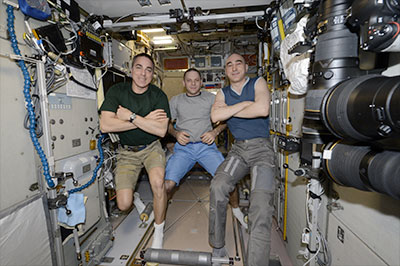 Ivan Vagner in Progress MS-15 as wash zone. 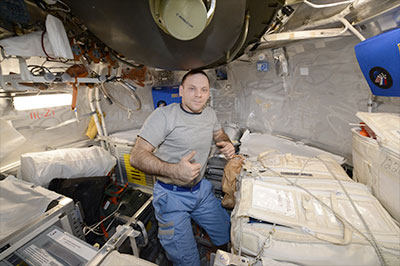 Chris Cassidy's sleeping place in Poisk module. 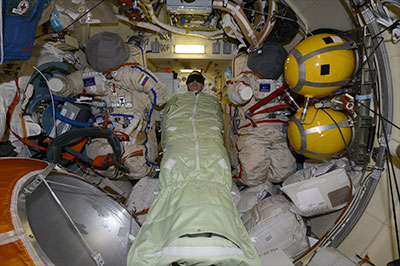 |
Robert Pearlman
Editor Posts: 46917
From: Houston, TX
Registered: Nov 1999
|
 posted 08-24-2020 05:18 PM
posted 08-24-2020 05:18 PM
   
NASA update Crew spends another day in Russian segmentThe three Expedition 63 crew members will spend another day inside the Russian segment of the International Space Station. Mission controllers are continuing their leak detection work today to collect more data. All of the orbiting lab's hatches will remain closed until Tuesday morning to give ground specialists additional time to collect data and monitor pressure readings in each module. |
Robert Pearlman
Editor Posts: 46917
From: Houston, TX
Registered: Nov 1999
|
 posted 08-25-2020 12:06 PM
posted 08-25-2020 12:06 PM
   
NASA update Station crew re-enters U.S operating segmentsThe Expedition 63 crew ended its stay isolated in the Russian segment of the International Space Station this morning (Aug. 25) after an extended leak test. Commander Chris Cassidy started the day reopening the hatches to the U.S. segment to begin resuming normal station operations. He reactivated U.S. life support equipment and restowed U.S. gear used during the crew's weekend stay in the Zvezda service module. Mission control will study the test data this week in an effort to determine the source of a cabin air leak detected in September of 2019. The rate is still well within segment specifications and presents no danger to the crew or the space station. Roscosmos Flight Engineer Anatoly Ivanishin spent the morning reconfiguring the Russian segment of the orbiting lab. The veteran station cosmonaut checked pressure valves and communications gear while opening hatches to various Russian modules. Flight Engineer Ivan Vagner, on his first station mission, started the day resetting Russian life support equipment and sampling the air in Zvezda for analysis. |
oly
Member Posts: 1255
From: Perth, Western Australia
Registered: Apr 2015
|
 posted 08-26-2020 07:38 AM
posted 08-26-2020 07:38 AM
   
Has any information been released why this method of leak detection was considered to be better suited than alternative methods used in the past to find ISS pressure leaks? |
Robert Pearlman
Editor Posts: 46917
From: Houston, TX
Registered: Nov 1999
|
 posted 09-24-2020 07:23 PM
posted 09-24-2020 07:23 PM
   
From Expedition 63 commander Chris Cassidy (via Twitter): Both Moscow and Houston Mission Control Centers have been tracking a tiny air leak for several months. A few weeks ago our crew isolated in the Russian segment of space station and closed as many hatches as possible in order to identify the location of the leak.Strangely the data did not point us to any particular location. Yesterday and today, Anatoly [Ivanishin] and I have been checking all of the window seals (not Navy SEALs) for any indication of a leak using an ultrasonic leak detector. So far no luck finding the source, but it looks like we will try again with the module isolation this weekend. No harm or risk to us as the crew, but it is important to find the leak we are not wasting valuable air. 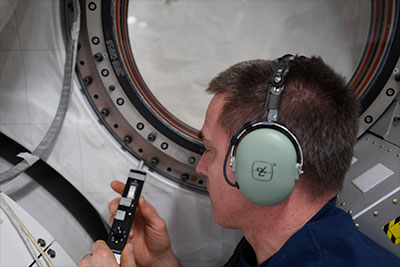 |
oly
Member Posts: 1255
From: Perth, Western Australia
Registered: Apr 2015
|
 posted 09-24-2020 07:52 PM
posted 09-24-2020 07:52 PM
   
Time for the old soap bubble test? |
GACspaceguy
Member Posts: 2727
From: Guyton, GA
Registered: Jan 2006
|
 posted 09-25-2020 05:04 AM
posted 09-25-2020 05:04 AM
   
Hard to keep them bubbles together in the vacuum of space since the leak is from the inside to the outside.  |
ejectr
Member Posts: 1855
From: Killingly, CT
Registered: Mar 2002
|
 posted 09-25-2020 10:22 AM
posted 09-25-2020 10:22 AM
   
Man, that David Clark headset doesn't look too comfortable. |
Robert Pearlman
Editor Posts: 46917
From: Houston, TX
Registered: Nov 1999
|
 posted 09-29-2020 10:03 AM
posted 09-29-2020 10:03 AM
   
From Roscosmos (via Twitter): After a thorough analysis and search of the air leak at the International Space Station, the leak was located in the Zvezda Service Module containing scientific equipment.The leak is localized in the working compartment of the service module. Currently the search is underway to precisely locate the leak. With that, the general atmosphere pressure decrease rates remain at 1 mm per 8 hours. The situation poses no danger to the crew's life and health and doesn't hinder the station continued crewed operation. |
Robert Pearlman
Editor Posts: 46917
From: Houston, TX
Registered: Nov 1999
|
 posted 09-29-2020 10:07 AM
posted 09-29-2020 10:07 AM
   
NASA release Crew Continues Troubleshooting as Tests Isolate Small LeakLate Monday night (Sept. 28), the Expedition 63 crew was awakened by flight controllers to continue troubleshooting a small leak on the International Space Station that appeared to grow in size. Ground analysis of the modules tested overnight have isolated the leak location to the main work area of the Zvezda Service Module. Additional work is underway to precisely locate the source of the leak. The leak, which has been investigated for several weeks, poses no immediate danger to the crew at the current leak rate and only a slight deviation to the crew's schedule. NASA astronaut and station commander Chris Cassidy and Roscosmos cosmonauts Anatoly Ivanishin and Ivan Vagner were instructed to move into the Russian segment to collect data at various locations in the Russian modules. The size of the leak identified overnight has since been attributed to a temporary temperature change aboard the station with the overall rate of leak remaining unchanged. Previous leak checks were conducted in the modules in the U.S. segment of the station. One by one, the crew closed hatches between Zvezda's aft and forward sections and Zvezda's passageways to the Pirs Docking Compartment and the Poisk module while using an ultrasound leak detector to collect data. Throughout the night, pressure measurements were taken by U.S. and Russian specialists to try to isolate the source of the leak. At the completion of the overnight checks, the crew opened hatches once again between the U.S. and Russian segments and resumed regular activities. |
Robert Pearlman
Editor Posts: 46917
From: Houston, TX
Registered: Nov 1999
|
 posted 10-02-2020 09:50 AM
posted 10-02-2020 09:50 AM
   
Anatoly Ivanishin and Ivan Vagner cut thin strips of paper and plastic, as well as pieces of foam, to place into the Zvezda service module along with two GoPro cameras before closing the hatches to the transfer chamber, where the air leak is suspected to be located. One of the cameras will look at the vacuum meter to understand how quickly the pressure in the compartment is dropping, and the other will watch the movement of indicators, which, according to experts, will indicate where the air leak is. The idea of the specialists is that due to the leak there will be a micro flow of air, due to which the fixed strips will deviate in the direction of the leak, and the freely floating strips will be grouped near the leak. In this case, video from cameras will be transmitted in real time to the crew and to the Earth. |
Robert Pearlman
Editor Posts: 46917
From: Houston, TX
Registered: Nov 1999
|
 posted 10-19-2020 11:43 AM
posted 10-19-2020 11:43 AM
   
Anatoly Ivanishin and Ivan Vagner used a tea bag to trace the source of the leak in the transfer module of the Zvezda service module. Ivanishin described the process in a call down to Moscow mission control on Oct. 15. We believe that we have really identified the probable leakage area. We have distributed a tea bag before closing the transfer chamber. We have several photos and videos of the direction of the tea bag’s flight or where it intended to fly and this precisely shows the direction the air is blowing from the possible air leak. The leak was traced back to a small fracture, which initially appeared to the crew as only a scratch. After a temporary patch, the leak continued but at a slower rate. On Monday (Oct. 19), Roscosmos said a permanent seal is being worked. ISS crew sealed the airleak using temporary means available at the station. Currently, Chief Operating Control Group together with the space station crew is working out a program of operations to permanently seal the leak location. |
Robert Pearlman
Editor Posts: 46917
From: Houston, TX
Registered: Nov 1999
|
 posted 03-02-2021 06:11 AM
posted 03-02-2021 06:11 AM
   
The work to permanently seal the crack in the intermediate chamber of the Zvezda module began on Monday (March 1) and will take five days, Russia's Flight Control Center said during talks with the orbital outpost on Monday, as reported by TASS. On March 1, the cosmonauts will fill the crack with the sealant, then lay polyurethane foam and patch up the fracture with the tape, the Flight Control Center specified."The work [must be carried out] with the use of individual protection gear," the specialist stressed. Specifically, the cosmonauts would need to use alcohol wipes and respirators and carry out work on command from Earth instead of using a timing diagram, he said. As follows from the talks, then a hole will be drilled at one of the fracture’s ends, which will be filled with cold welding and sealed with a fluoroplastic film on top. The same procedure will be done with other holes. After that, the surface will be sanded and wiped with alcohol wipes and covered with a sealant. Overall, the cosmonauts will put three layers of the sealant. |
oly
Member Posts: 1255
From: Perth, Western Australia
Registered: Apr 2015
|
 posted 03-02-2021 03:09 PM
posted 03-02-2021 03:09 PM
   
I have seen these types of structural patch jobs before, but never while the structure is pressurized and with the crew inside. I imagine that the person armed with the drill will be experiencing a great deal of trepidation.Think about this for a moment. Someone has to drill a hole through the pressurized skin of a spacecraft containing people, traveling at 17500mph. I wonder how many people on the ground are going to be holding their breath, about to turn blue?
|
Headshot
Member Posts: 1024
From: Vancouver, WA, USA
Registered: Feb 2012
|
 posted 03-02-2021 04:21 PM
posted 03-02-2021 04:21 PM
   
I wonder what size the hole will be? I know that when a 1-1/2 inch crack developed in the front element of the 40 inch Yerkes refracting telescope back in the late '70s, they had an optician drill a 1/4 inch stop hole. I would guess that the stop hole drilled in the Russian segment will be somewhat smaller. |
ejectr
Member Posts: 1855
From: Killingly, CT
Registered: Mar 2002
|
 posted 03-03-2021 08:18 AM
posted 03-03-2021 08:18 AM
   
My guess will be as small as possible, but big enough in diameter to exceed the crack width and also... not break the drill.A difficult task for anyone that is earth bound, never mind on the ISS, which is pressurized and the person weightless. |
David C
Member Posts: 1286
From: Lausanne
Registered: Apr 2012
|
 posted 03-03-2021 08:44 AM
posted 03-03-2021 08:44 AM
  
quote:
Originally posted by oly:
Someone has to drill a hole through the pressurized skin of a spacecraft containing people, traveling at 17500mph.
Stop-drilling is a very well understood technique, even if being pressurized whilst performing it seems far from ideal (is it really necessary). My concern is how did we get here in the first place? Metal fatigue? The ISS isn’t an airplane. It’s not like it’s going through frequent full pressurization cycles. |
Headshot
Member Posts: 1024
From: Vancouver, WA, USA
Registered: Feb 2012
|
 posted 03-03-2021 09:37 AM
posted 03-03-2021 09:37 AM
   
But it does go through about 16 stressful thermal cycles a day, or 5840 cycles a year. |
David C
Member Posts: 1286
From: Lausanne
Registered: Apr 2012
|
 posted 03-03-2021 09:42 AM
posted 03-03-2021 09:42 AM
  
Good point. |
GACspaceguy
Member Posts: 2727
From: Guyton, GA
Registered: Jan 2006
|
 posted 03-03-2021 12:34 PM
posted 03-03-2021 12:34 PM
   
quote:
Originally posted by David C:
Stop-drilling is a very well understood technique...
In my 40+ years as a Service Engineer I can tell you a stop drill is a short term solution. The crack always propagates beyond the stop drill hole after some number of cyclic loads. The stop drill needs to be 0.25 inch diameter or better and smoothed out for any significant life. Now, that said, I am sure they have done the fatigue analysis and projected life of the ISS to determine that this is an acceptable go forward plan for the life of the ISS. |
Robert Pearlman
Editor Posts: 46917
From: Houston, TX
Registered: Nov 1999
|
 posted 03-03-2021 12:49 PM
posted 03-03-2021 12:49 PM
   
quote:
Originally posted by David C:
My concern is how did we get here in the first place?
Citing a source "in the rocket and space sphere," Sputnik reports today: "They are studying the possibility of the seal failure due to metal fatigue or the impact of a micrometeorite, which could pierce the assembly compartment [under which the intermediate chamber is located]," the source said.According to the source, Russian cosmonauts will examine the Zvezda module's surface during a spacewalk in the summer to detect the micrometeorite's impact that could cause an air leak. |
David C
Member Posts: 1286
From: Lausanne
Registered: Apr 2012
|
 posted 03-03-2021 01:33 PM
posted 03-03-2021 01:33 PM
  
quote:
Originally posted by GACspaceguy:
In my 40+ years as a Service Engineer I can tell you a stop drill is a short term solution.
Yup, and in my experience you stop-drill it again, and again, and...Doesn't sound good in a pressurized structure. New Zvezda module anyone? Well, at least a better patch. |
Robert Pearlman
Editor Posts: 46917
From: Houston, TX
Registered: Nov 1999
|
 posted 03-09-2021 08:30 AM
posted 03-09-2021 08:30 AM
   
Roscosmos released additional information about the repairs: Microscopic and eddy-current flaw testing of the affected area showed that one of the cracks is 22 mm long and only about 100 microns wide. Given the minor sizes, it was impossible to discover the cracks using onboard equipment only.The results of the thorough study were sent back to Earth to develop the repair method. Currently, works are underway to localize and hermetically seal the cracks; the works are to be conducted for the next few days. To seal the cracks, two types of sealing paste and sealing material are to be used. The edges of the cracks will be drilled with a 3-mm drill to limit possible crack growth. The holes will be sealed straight away to minimize the pressure drop. After that, several more layers of seal paste will be applied with a reinforced patch, which will be covered with another layer of sealing paste. The metal borings will be sent back to Earth in addition to the instrument data and photos collected earlier for further analysis. After completing the works, a leak check of the Transfer Chamber will be performed. And from TASS, citing RSC Energia: All the Russian crew's operations are being agreed with NASA specialists stage-by-stage on an instruction from state corporation Roscosmos chief Dmitry Rogozin.Last week, cosmonaut Ryzhikov applied three layers of a sealant and placed a patch on the first crack in the Zvezda module. On March 6, he applied another layer of the sealant from the end of the installed patch. The cosmonauts will carry out the work to seal the second fracture this week. On March 8, the cosmonauts elaborated a detailed plan under the direction of specialists from the ISS Russian Segment's main operational control group for further repair and recovery work. The Russian crewmembers also prepared the necessary equipment for treating the module's surface, applying the sealant and placing a patch. |
Robert Pearlman
Editor Posts: 46917
From: Houston, TX
Registered: Nov 1999
|
 posted 03-11-2021 08:01 AM
posted 03-11-2021 08:01 AM
   
From Roscosmos (via Twitter): The International Space Station crew has completed the repair works of the Zvezda module hull. In the coming days Roscosmos cosmonauts Sergey Ryzhikov and Sergey Kud-Sverchkov will close the Zvezda module hatches to perform pressure level checks. 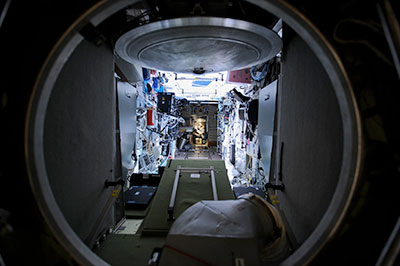 |
SpaceAholic
Member Posts: 4912
From: Sierra Vista, Arizona
Registered: Nov 1999
|
 posted 08-30-2021 11:44 AM
posted 08-30-2021 11:44 AM
   
Russian cosmonauts have discovered new cracks in the functional cargo block (FGB) of the International Space Station that could widen, reports Reuters. "Superficial fissures have been found in some places on the Zarya module," Vladimir Solovyov, chief engineer of rocket and space corporation Energia, told RIA news agency. "This is bad and suggests that the fissures will begin to spread over time."He did not say if the cracks had caused any air to leak. The space official has said previously that much of the International Space Station's equipment is starting to age and has warned there could be an "avalanche" of broken equipment after 2025. |
oly
Member Posts: 1255
From: Perth, Western Australia
Registered: Apr 2015
|
 posted 08-30-2021 10:09 PM
posted 08-30-2021 10:09 PM
   
A few questions that come to mind:Were these cracks there before the new Russian module thrusters went haywire? Is the area these cracks were found subject to significant cabin pressure or temperature changes? Is the area these cracks were found insulated externally by material that conducts or radiates heat? Can additional external shielding be applied to this area without interfering with the external functions of the ISS? Can vibrations caused by crew movement or solar panel movement become concentrated at a nodal point in the area these cracks were found or are torque forces from solar panel movement being applied to the structure at this point vial the truss structure? What do these cracks propagate from? A weld, rivet hole, cut out, material defect, etc. |

















